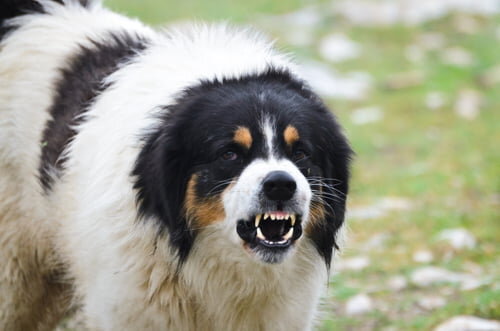How to Train Your Livestock Guardian Dog to Love Wearing a Muzzle!
Some livestock guardian dogs are aggressive to strangers (such as the vet) and may need to undergo muzzle-training.
As an Amazon Associate, I earn from qualifying purchases at no extra cost to you.
Our livestock guardian dogs (LGDs) would give life and limb to protect both us and our livestock, but they aren’t always so keen on other animals or people.
Some breeds, such as Kangals or Central Asian Shepherds, tend to be more aggressive than others on average. And LGDs of any breed can be aggressive to strangers if they haven’t been properly socialized. I’ve even known some Great Pyrenees dogs to be aggressive, and this breed is known as the gentle giant!
All livestock guardian dog breeds are large and powerful. Some individuals weigh 200 pounds or more. They can do major damage to others if they feel threatened!
For these reasons, you may need to train your dog to wear a muzzle for vet visits, or when she has to be around new people and animals. I recommend socialization as a better long-term option for your dog, but for ranchers or homesteaders living in remote locations, socialization may not be an option.
Are dog muzzles humane?
Not all muzzles are humane. Some muzzles make it difficult for dogs to breathe or drink water. And forcing your dog to wear a muzzle for an extended period of time or unsupervised is inhumane and dangerous.
However, if you use the right kind of muzzle (see below), you can train your dog to actually enjoy putting on a muzzle and wearing it around. That’s always the goal of positive training: get your dog to want to follow the command.
The instructions in this article will teach you exactly how to get your dog to want to wear a muzzle.
What type of muzzle should you get for your livestock guardian dog?
The most humane type of muzzle is called a basket muzzle—you can buy one here on Amazon. These muzzles are designed for canine comfort and safety.
Basket muzzles are open enough that dogs can breathe well, drink water, and take treats while wearing them. The muzzle allows enough space for your dog to be able to pant when she’s overheated—this is a must-have for a large, heavy-coated LGD!
How to train your livestock guardian dog to the muzzle
As always, you need to be very patient in training your dog. Some dogs will learn quickly. Others will need a lot more time and help. Make sure your dog has had exercise before training and that the environment is calm and relaxed. You don’t want your dog to be distracted when you first start out.
Step one: Introduce the muzzle
Place the muzzle on the ground.
Let your dog sniff the muzzle.
Move it around on the floor some.
Show your dog the muzzle is not a scary object.
When your dog sniffs the muzzle or shows interest in the muzzle, give her a treat. You want to associate the muzzle with positive feelings.
Step two: Get your dog to voluntarily put her nose in the muzzle with a treat lure
Hold the muzzle with the open end toward your dog, on her level.
Hold a treat on the other side of the muzzle to entice your dog to place her nose in the muzzle. Some dogs will do this right away, others are more suspicious.
Keep feeding tiny pieces of treats through the muzzle, just barely holding the bottom of it for support. This should be a non-stressful event for your dog.
Once you are out of treats, simply drop your support hand and let the muzzle fall to the ground.
Repeat until your dog seems comfortable with the muzzle.
Step three: Get your dog to voluntarily put her nose in the muzzle without a treat lure
Hold out the muzzle.
Let your dog examine it.
Once your dog puts her nose in the muzzle, say “yes, good” and reward her with a treat when she removes her nose.
Repeat as needed.
Step four: Teach the command
Say “put your muzzle on.”
Once your dog puts her nose in the muzzle, say “yes, good” and reward her as soon as she takes her nose out.
Repeat as needed.
Step five: Secure the muzzle collar
Put the strap around your dog’s neck, but do not secure it. Just let it drop to the floor.
Give your dog a treat.
Put the strap around your dog’s neck and secure it this time but let the muzzle hang, do not try to put the actual muzzle portion on yet.
Give your dog a treat.
Step Six: Putting it Altogether
Repeat step five so the muzzle strap is secure but the muzzle is hanging from your dog’s neck.
Hold the muzzle up and say “put your muzzle on.”
When your dog puts her nose in the muzzle, say “yes, good.” Give her a treat through the muzzle (don’t have her take her nose out first like in previous steps).
Secure the top portion of the muzzle. If your dog has been more nervous throughout this process, secure the top slowly and make sure to give lots of praise and treats.
Below is an excellent video that demonstrates this training process:
Please let me know in the comments below how muzzle training goes for you and your dog. Happy training!
You May Also Be Interested in:
Brain Training for Dogs: The Best Online Obedience Training Program for Livestock Guardian Dogs
The 4 Commands Your Livestock Guardian Dog Must Know: Come, Leave It, Off, and Look at Me


